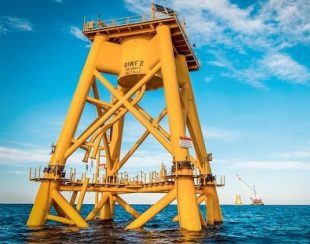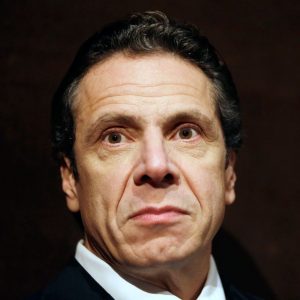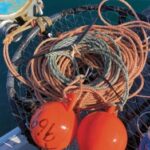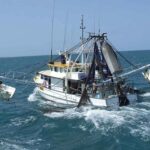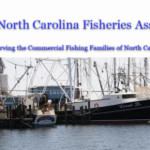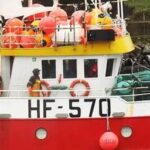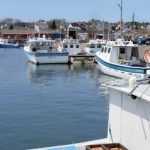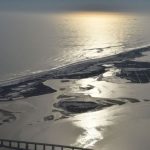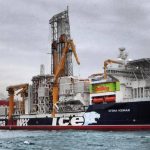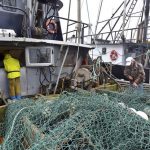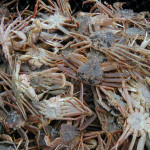Tag Archives: Deepwater Wind
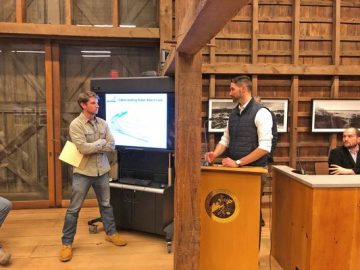
Highest Hurdle For Deepwater May Be Winning The Trust Of The Region’s Fishing Community
Deepwater Wind faces two years of review by some 20 state and federal agencies, and millions of dollars in scientific survey work covering hundreds of square miles of the ocean, to answer the questions the agencies will pepper them with about the wind farm’s effect on the ocean around it.,, Part of the federal process that the company must follow, in attempting to show that the 15 wind turbines they want to build in the ocean east of Block Island can coexist with those who make a living at sea, requires that they appoint a “fisheries representative” >click here to read< 09:47

New Bedford–based offshore wind farm gets a ‘no’ for state contract
A New Bedford–based offshore wind proposal by Deepwater Wind has been passed over for a state contract in favor of hydroelectric power from Canada. Gov. Charlie Baker’s administration announced Thursday that Northern Pass Hydro, a joint venture of Eversource and Hydro-Québec, has been selected to provide power to Massachusetts in the first of two competitive bidding processes created by the state’s 2016 energy diversity law. >click here to read< 11:43
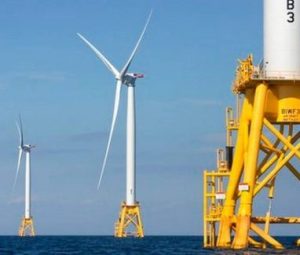
Fishermen say Deepwater data falls short of assurances
Fishermen and their advocates this week ramped up criticisms of Deepwater Wind and its efforts to prove that the planned South Fork Wind Farm would not hurt fishing off Long Island, challenging the basis of the company’s data and its adherence to the required review process. On Friday, fishermen and East Hampton Town Trustees again spotlighted what they say is a dearth of information from Deepwater’s scientists that pertains directly to the marine species that migrate through the region and their sensitivity to electrical currents, at an hours-long meeting with company representatives and members of the Trustees board. And on Monday a group of fishermen and fishing-related business owners released their own detailed assessment,, >click here to read< 09:06
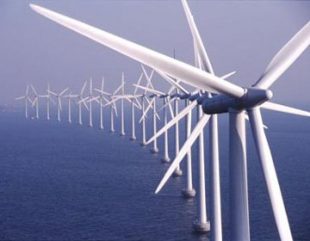
Avangrid Pursuing Huge Offshore & Onshore Wind Projects In US
Avangrid Renewables is pursuing two new wind projects, one off the coast of Massachusetts and another in the heart of New Mexico. It is working with Copenhagen Infrastructure Partners on a bid to build an offshore wind farm in waters off the coast of Massachusetts. That partnership is known as Vineyard Wind.,, Two other partnerships have submitted bids to the state of Massachusetts, which plans to have up to 1.6 gigawatts (GW) of offshore power in place by 2027. click here to read the story 11:26

In 2018, Thorny Issues Ahead – Fishermen versus wind farm, beach access at Napeague remain unresolved
The proposed South Fork Wind Farm occupied the attention of many residents and governing officials throughout 2017 and, if anything, will be a matter of greater debate next year as its developer, Rhode Island-based Deepwater Wind, submits formal applications to multiple federal, state, and local permitting agencies.,, Most recently, commercial fishermen and Deepwater Wind are at odds over reports by the former that their trawl nets have snagged on the concrete mats that cover approximately 5 percent of the Block Island Wind Farm’s transmission cable. click here to read the story 09:41

Winds of worry: US fishermen fear forests of power turbines
East Coast fishermen are turning a wary eye toward an emerging upstart: the offshore wind industry. In New Bedford, Massachusetts, the onetime whaling capital made famous in Herman Melville’s “Moby-Dick,” fishermen dread the possibility of navigating a forest of turbines as they make their way to the fishing grounds that have made it the nation’s most lucrative fishing port for 17 years running. The state envisions hundreds of wind turbines spinning off the city’s shores in about a decade, enough to power more than 1 million homes.,, “Fishermen are losing ground one a nibble at a time,” said Joseph Gilbert, a Stonington, Connecticut fisherman who owns boats that range from Virginia to Maine. click here to read the story 12:30

Fishermen’s Doubts Persist on South Fork Wind Farm
As 2018 approaches, so does Deepwater Wind’s plan to submit applications to more than 20 federal, state, and local permitting agencies for the South Fork Wind Farm, an installation of up to 15 turbines it plans to construct approximately 30 miles east of Montauk. With a first-quarter deadline to submit those applications looming, commercial fishermen in East Hampton remain generally opposed to the project,,, The specific concern voiced at the town trustees’ Dec. 11 meeting, and again at last Thursday’s meeting of its harbor management committee, is the prospect of trawl nets getting caught on them, which fishermen say would be both costly and potentially deadly. click here to read the story 14:18
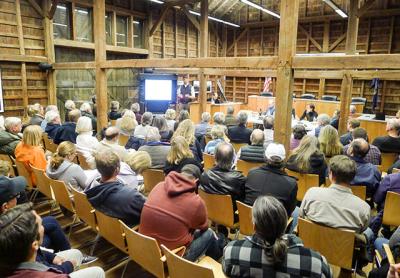
“You’re going into our fishing grounds,” – Fishermen Demand Answers on Wind Power Plan
An effort by Deepwater Wind, the Rhode Island company that plans to construct the South Fork Wind Farm approximately 30 miles east of Montauk, to alleviate the concerns of skeptical fishermen over disruption or destruction of their livelihood took an incremental step forward when the company’s president and vice president of development addressed a standing-room-only crowd at East Hampton Town Hall on Monday. Concerns remain, however, with commercial fishermen demanding to see data that Deepwater Wind has promised but has yet to produce, along with assurances that they will be compensated for losses resulting from construction or operation of the wind farm. click here to read the story 08:08

Deepwater struggles to assuage concerns of fishermen
Commercial fishermen peppered representatives of Deepwater Wind this week with concerns, questions and “what-if” scenarios about the planned offshore wind farm’s feared impacts on marine life and the men who work the waters for a living. The company, which is planning to spend more than $700 million to construct 15 wind turbines in the ocean 30 miles southeast of Montauk, walked a standing-room-only audience at the East Hampton Town Trustees meeting on Monday night through the coming permitting and presumed construction process that will follow. Its officials also tried to again assuage the concerns of fishermen about the effects the South Fork Wind Farm will have on fishing. click here to read the story 08:13
Fishermen Demand Answers on Wind Power Plan – “You’re going into our fishing grounds,” Hank Lackner, owner of the 90-foot trawler Jason & Danielle, told the Deepwater Wind officials. Visibly angry, he demanded details as to how fishermen would be compensated for interruptions, likening that compensation to the incentives offered to the town, which he said are effectively bribery. “When I can’t fish where I have for decades . . . and have to change my business operations, what are you going to do?” click here to read the story18:36 12/14
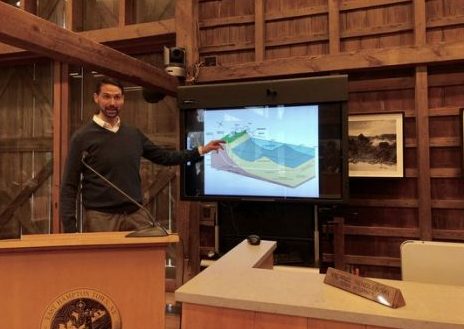
Wind Farm Cable Would Come Ashore In Wainscott; Company Would Fund Fisheries And Scenic Improvements
Deepwater Wind has told the East Hampton Town Board that it has identified Beach Lane in Wainscott as the preferable place for the cable from the 15-turbine wind farm planned southeast of Montauk to come ashore and connect to the South Fork power grid.,,,Additionally, the company is pledging to give the East Hampton Town Trustees $600,000, in two dedicated funds, for improving fisheries habitat and other environmental improvements on Town Trustees-controlled wetlands and bay bottoms. click here to read the story 10:06
LI fishing grounds mapped as wind farm plans take shape
 More than a dozen Montauk fishermen have met with state officials to mark off vital fishing areas on a map that will help determine the best places for the hundreds of offshore wind turbines anticipated for the waters off Long Island. Led by the Long Island Commercial Fishing Association, the group included trawl-boat captains, lobstermen, gill netters and trappers, each determined to preserve their fishing grounds as plans for wind-energy farms take shape. New York State’s offshore wind plan foresees some 2,400 megawatts of wind-turbines in New York and surrounding waters. That is likely to translate to around 240 turbines. click here to read the story 18:49
More than a dozen Montauk fishermen have met with state officials to mark off vital fishing areas on a map that will help determine the best places for the hundreds of offshore wind turbines anticipated for the waters off Long Island. Led by the Long Island Commercial Fishing Association, the group included trawl-boat captains, lobstermen, gill netters and trappers, each determined to preserve their fishing grounds as plans for wind-energy farms take shape. New York State’s offshore wind plan foresees some 2,400 megawatts of wind-turbines in New York and surrounding waters. That is likely to translate to around 240 turbines. click here to read the story 18:49
Fishermen, Public Invited to Meeting With Deepwater Wind
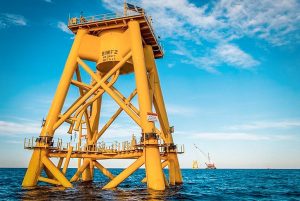 The East Hampton Town Trustees’ harbor management committee will host officials from Deepwater Wind, the Rhode Island company planning to construct a 15-turbine wind farm approximately 30 miles from Montauk, when it meets on Wednesday at 6 p.m. The meeting will be held at the trustees’ offices at the Donald Lamb Building in Amagansett. The public, particularly members of the town’s commercial fishing industry, has been invited to attend, according to Rick Drew, who heads the committee and is a deputy clerk of the trustees. click here to read the story 11:09
The East Hampton Town Trustees’ harbor management committee will host officials from Deepwater Wind, the Rhode Island company planning to construct a 15-turbine wind farm approximately 30 miles from Montauk, when it meets on Wednesday at 6 p.m. The meeting will be held at the trustees’ offices at the Donald Lamb Building in Amagansett. The public, particularly members of the town’s commercial fishing industry, has been invited to attend, according to Rick Drew, who heads the committee and is a deputy clerk of the trustees. click here to read the story 11:09

Wind farm officials hear fishermen’s pleas, Deepwater Now Exploring New Cable Route
In response to strong opposition from commercial fishermen who fear a disruption of their work and destruction of fish habitat, officials of Deepwater Wind, a Rhode Island company that plans to construct a 15-turbine wind farm approximately 30 miles off Montauk, are exploring an alternative to an initial plan to route the installation’s transmission cable through Gardiner’s Bay. At an April meeting of the East Hampton Town Trustees, several fishermen voiced those concerns to Clint Plummer, Deepwater Wind’s vice president of development, should the transmission cable be laid to make landfall in Gardiner’s Bay. click here to read the story 20:25

Offshore Wind Faces Stiff Test From Hurricanes
As new offshore wind farms are built off the Northeast coast, a new report suggests that the current models of wind turbines may not withstand the most powerful of hurricanes. The study, by the University of Colorado Boulder, the National Center for Atmospheric Research and the U.S. Department of Energy, is intended to help the budding offshore wind industry as it expands into hurricane-prone regions, such as the East Coast. “We wanted to understand the worst-case scenario for offshore wind turbines, and for hurricanes, that’s a Category 5,” said Rochelle Worsnop, lead author and a graduate researcher in the University of Colorado’s Department of Atmospheric and Oceanic Sciences (ATOC). click here to read the story 10:58
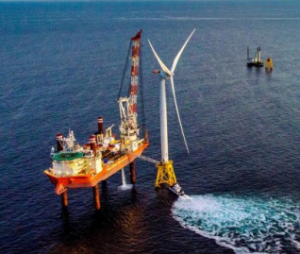
Deepwater Wind accepts Maryland PSC approval; will move forward on Skipjack Wind Farm
Deepwater Wind LLC accepted the Maryland Public Service Commission’s approval of its Skipjack Wind Farm project, a planned 15 turbine wind farm 19.5 miles off the coast of Maryland the company announced in a press release in May. The plant will provide 120 megawatts, what the company says is enough power to support 35,000 homes. It is expected to cost $720 million. According to the Skipjack wind farm application in November, Deepwater Wind also committed to $6,000,000 into the Maryland Offshore Wind Business Development Fund. Deepwater Wind also signed contract to build a wind farm off the coast of Long Island earlier this year. click here to read the story 16:11
East Hampton Fisheries Advisory Committee Urge Study on Importance of Fisheries
 Representatives of East Hampton Town’s Fisheries Advisory Committee this week again asked the town to help fund a comprehensive analysis of the socioeconomic importance of fisheries on the East End and reiterated fishermen’s concerns about the Deepwater Wind offshore turbine installation. The committee would like to hire Cornell Cooperative Extension to conduct the economic analysis, and its members are seeking participation from East Hampton and other local municipalities in order to raise the $100,000 needed to pay for it. Brad Loewen, the chairman of the fisheries committee, who is a bayman and a former town councilman, said the committee has also been examining how — or if — the State Department of Environmental Conservation considers potential detrimental effects on fisheries when assessing the impact of proposed projects, such as the offshore wind farm. With unsatisfactory responses so far from the D.E.C. to requests for information, the committee, which is working with John Jilnicki, a town attorney, may ask the town board to submit a Freedom of Information Law request for the needed documents. click here to read the story 08:52
Representatives of East Hampton Town’s Fisheries Advisory Committee this week again asked the town to help fund a comprehensive analysis of the socioeconomic importance of fisheries on the East End and reiterated fishermen’s concerns about the Deepwater Wind offshore turbine installation. The committee would like to hire Cornell Cooperative Extension to conduct the economic analysis, and its members are seeking participation from East Hampton and other local municipalities in order to raise the $100,000 needed to pay for it. Brad Loewen, the chairman of the fisheries committee, who is a bayman and a former town councilman, said the committee has also been examining how — or if — the State Department of Environmental Conservation considers potential detrimental effects on fisheries when assessing the impact of proposed projects, such as the offshore wind farm. With unsatisfactory responses so far from the D.E.C. to requests for information, the committee, which is working with John Jilnicki, a town attorney, may ask the town board to submit a Freedom of Information Law request for the needed documents. click here to read the story 08:52

Offshore Wind Farm Costs $150,000 Per Home Currently Powered
An offshore wind farm in Rhode Island went online Monday, but building it costed $150,000 for every household powered. Three miles off the coast of Block Island, R.I., the wind farm is currently generating enough electricity to power 2,000 homes, but building the five turbines costed $300 million. That’s roughly $150,000 per household just to build the turbines, not to operate them. To put this in some perspective, the U.S.’s newest nuclear reactor, Watts Bar Unit 2, cost $4.7 billion to build but powered 4.5 million homes. The extremely high cost of offshore wind doesn’t worry environmentalists and progressives however, because, “it’s the precedent that counts.” click here to read the rest 11:37
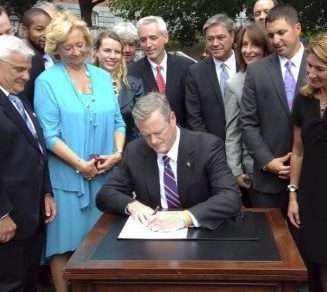
Not exactly a breeze: Offshore wind still faces challenges
Amid all of the challenges that could face offshore wind power along the East Coast — legal disputes from commercial fishing advocates, construction plans altered by whale migrations, President Donald Trump’s emphasis on revitalizing fossil fuels and more — some promising news for renewable industry supporters arrived in mid-March. That’s when a telling indication of how offshore wind power might fare under President Trump was delivered, after an uncertain, wait-and-see winter. Following months of silence about offshore wind, a statement by Secretary of the Interior Ryan Zinke gave an early glimpse of the administration’s tone. click here to read the story 09:22
Deepwater Wind Confronted – Fishermen ask trustees to fight offshore wind farm
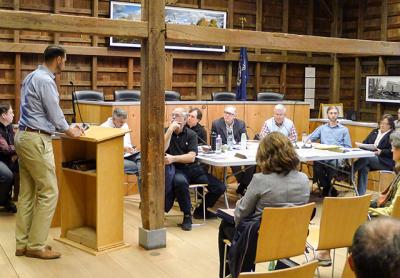 A representative of the Rhode Island company that is planning a 15-turbine wind farm 30 miles off Montauk faced sharp questions from fishermen and other residents at the East Hampton Town Trustees meeting on Monday, as well as from the trustees themselves. A lengthy presentation and a subsequent question-and-answer session occupied more than half of the nearly four-hour meeting, as fishermen voiced fears of disruption and even the outright destruction of their livelihood. “Most of fishermen I know, we are against this project from the beginning to the end,” Terry Wallace said to applause. Brad Loewen, chairman of the East Hampton Town Fisheries Advisory Committee, criticized Deepwater’s effort to hire fisheries representatives here. “You can try to buy advice, you can try to buy trawl surveys, you can try to buy scientific data,” he said. “I would suggest . . . that you don’t necessarily listen to somebody that was hired by them,” he told the trustees. “Listen to the people doing the job, somebody actually out trawling, running around that bay, trying to catch fish, and trying to make a living.” click here to read the story 14:18
A representative of the Rhode Island company that is planning a 15-turbine wind farm 30 miles off Montauk faced sharp questions from fishermen and other residents at the East Hampton Town Trustees meeting on Monday, as well as from the trustees themselves. A lengthy presentation and a subsequent question-and-answer session occupied more than half of the nearly four-hour meeting, as fishermen voiced fears of disruption and even the outright destruction of their livelihood. “Most of fishermen I know, we are against this project from the beginning to the end,” Terry Wallace said to applause. Brad Loewen, chairman of the East Hampton Town Fisheries Advisory Committee, criticized Deepwater’s effort to hire fisheries representatives here. “You can try to buy advice, you can try to buy trawl surveys, you can try to buy scientific data,” he said. “I would suggest . . . that you don’t necessarily listen to somebody that was hired by them,” he told the trustees. “Listen to the people doing the job, somebody actually out trawling, running around that bay, trying to catch fish, and trying to make a living.” click here to read the story 14:18
When it comes to in the Atlantic east of Montauk, the Fishing Industry must be considered
 Many in the commercial fishing industry are frustrated with the pace of planning a planned wind farm in the Atlantic east of Montauk. The project, they say, will hurt their ability to make a living and they are feeling left behind by public officials and by public sentiment, which appears largely supportive. Aware of these concerns, Deepwater Wind, the company planning the turbines, wants to hire a handful of local representatives to help smooth the waters. Balancing the needs of fishermen with the increasing call for renewable energy is a tough order. Seafood harvesters here have long expressed displeasure at what they see as excessive and unnecessary regulation. Now, with the industrialization of portions of their fishing grounds, they fear a slippery slope in which productive areas are put out of reach. Their concerns are important and have to be weighed carefully. click here to read the Op-Ed 17:14
Many in the commercial fishing industry are frustrated with the pace of planning a planned wind farm in the Atlantic east of Montauk. The project, they say, will hurt their ability to make a living and they are feeling left behind by public officials and by public sentiment, which appears largely supportive. Aware of these concerns, Deepwater Wind, the company planning the turbines, wants to hire a handful of local representatives to help smooth the waters. Balancing the needs of fishermen with the increasing call for renewable energy is a tough order. Seafood harvesters here have long expressed displeasure at what they see as excessive and unnecessary regulation. Now, with the industrialization of portions of their fishing grounds, they fear a slippery slope in which productive areas are put out of reach. Their concerns are important and have to be weighed carefully. click here to read the Op-Ed 17:14
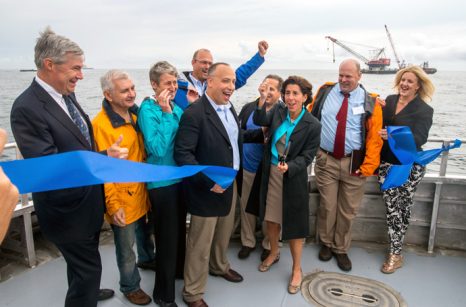
Central Coast should look to Rhode Island for bad experience with wind turbines
Our commercial fishermen met with the Bureau of Ocean Energy Management, and the bureau plans on putting hundreds of wind turbines off our coastline, taking hundreds of square miles of ocean away from fishing. We spoke with fishermen on the East Coast that had five wind turbines installed off Rhode Island, and they had nothing good to say. The installation required huge cement slabs on the bottom. The blades cause radar interference for miles. They are in squid and scallop fishing grounds, costing hundreds of jobs and millions of dollars lost to Rhode Island. They are placing them in navigation lanes, causing shipping vessels to travel around them. Also, most of the time they don’t work! They need repair constantly, and if the wind blows over 50 mph, they have to shut them down! They are being federally subsidized by millions of taxpayer dollars to mainly companies from other countries! It’s costing four times the amount it costs them for natural gas-powered electricity. Gov. Jerry Brown thinks using our oceans for energy is what we need. He is wrong. The ocean is a food source. It is wild and powerful and is not meant for industrialization. Tom Hafer, Atascadero link 09:19
Cable Under Gardiner’s Bay Sparks Debate – Trustees, baymen talk wind farm landing sites
 When officials of Deepwater Wind, the Rhode Island company that plans to construct an offshore wind farm 30 miles from Montauk, presented its plans to the community at Clinton Academy in East Hampton on March 9, several commercial fishermen in attendance voiced opposition, fearing a negative impact on their livelihood. That concern resurfaced on Monday night, when the East Hampton Town Trustees heard from several residents. Mr. (Gary) Cobb wondered “what jet-plowing is going to do to the bottom of Gardiner’s Bay.” The Air Force veteran, who studied avionics systems technology, also questioned “the proximity of these transmission lines to not just significant coastal wildlife habitat, but essential fish habitat.” continue reading the story here 17:13
When officials of Deepwater Wind, the Rhode Island company that plans to construct an offshore wind farm 30 miles from Montauk, presented its plans to the community at Clinton Academy in East Hampton on March 9, several commercial fishermen in attendance voiced opposition, fearing a negative impact on their livelihood. That concern resurfaced on Monday night, when the East Hampton Town Trustees heard from several residents. Mr. (Gary) Cobb wondered “what jet-plowing is going to do to the bottom of Gardiner’s Bay.” The Air Force veteran, who studied avionics systems technology, also questioned “the proximity of these transmission lines to not just significant coastal wildlife habitat, but essential fish habitat.” continue reading the story here 17:13
1st US Offshore Wind Turbine Breaks Before It Even Opened For Business!
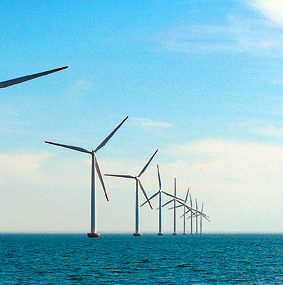 A wind turbine that’s part of the first U.S. offshore wind farm broke down before the site started commercially producing power. It’s not clear why the turbine isn’t spinning and generating electricity, says Block Island wind farm owner Deepwater Wind, but the company suspects the turbine’s generator was damaged by a drill bit accidentally left inside. Deepwater Wind claims that it will be repaired and working “in the near term,”. The offshore wind farm was supposed to open last month, but developers are still awaiting final approval. Commercial operations of the wind turbines are set to begin later this month. Three miles off the Rhode Island coast, Block Island was supposed to generate enough electricity to power 17,000 homes. But the five turbines would have cost $300 million each, effectively $17,600 dollars per home — and that doesn’t include the costs of operating the turbines. Link 14:19
A wind turbine that’s part of the first U.S. offshore wind farm broke down before the site started commercially producing power. It’s not clear why the turbine isn’t spinning and generating electricity, says Block Island wind farm owner Deepwater Wind, but the company suspects the turbine’s generator was damaged by a drill bit accidentally left inside. Deepwater Wind claims that it will be repaired and working “in the near term,”. The offshore wind farm was supposed to open last month, but developers are still awaiting final approval. Commercial operations of the wind turbines are set to begin later this month. Three miles off the Rhode Island coast, Block Island was supposed to generate enough electricity to power 17,000 homes. But the five turbines would have cost $300 million each, effectively $17,600 dollars per home — and that doesn’t include the costs of operating the turbines. Link 14:19
RI Fishermen, Scientists Study Impact Of Offshore Wind Farm On Fisheries
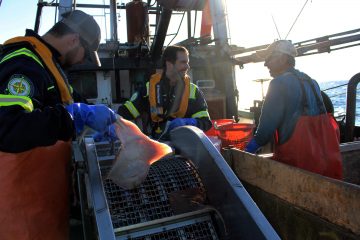 Every month for the past four and a half years, Captain Rodman Sykes has sailed out toward the Block Island Sound with his crew and a small group of scientists. They tow a fish net and scrape the seafloor twice in three different locations: within the area of the Block Island Wind Farm and in areas close to it for reference. “Mostly skates, there’s a sea bass and a few small scup, sea robins, dog fish,” Sykes says aloud as he stands over the fish to inspect them each time his crew brings up the net and releases the catch. “Not much else, but a good sample. So we’ll go on to the next station.” While Sykes redirects his vessel to the next sampling area, scientists get right to work: sorting fish by species, taking their weight, and measuring their length. Together these scientists and fishermen make up the research team hired by Deepwater Wind to collect data to understand the wind farm’s impacts to fish and shellfish. Sykes says at first that didn’t sit well with a small group of fishermen. “I had guys question me about ‘why are you working for the wind farm?’” recalls Sykes. “I told them, ‘I am not working for the wind farm, I am working for the fishing community.’” Read the story here 10:40
Every month for the past four and a half years, Captain Rodman Sykes has sailed out toward the Block Island Sound with his crew and a small group of scientists. They tow a fish net and scrape the seafloor twice in three different locations: within the area of the Block Island Wind Farm and in areas close to it for reference. “Mostly skates, there’s a sea bass and a few small scup, sea robins, dog fish,” Sykes says aloud as he stands over the fish to inspect them each time his crew brings up the net and releases the catch. “Not much else, but a good sample. So we’ll go on to the next station.” While Sykes redirects his vessel to the next sampling area, scientists get right to work: sorting fish by species, taking their weight, and measuring their length. Together these scientists and fishermen make up the research team hired by Deepwater Wind to collect data to understand the wind farm’s impacts to fish and shellfish. Sykes says at first that didn’t sit well with a small group of fishermen. “I had guys question me about ‘why are you working for the wind farm?’” recalls Sykes. “I told them, ‘I am not working for the wind farm, I am working for the fishing community.’” Read the story here 10:40
LIPA trustees won’t vote on wind farm project this week
 The state of New York has finalized a blue print for offshore wind energy, but the LIPA board won’t take up a measure to authorize the utility to move ahead with a contract this week. An agenda for the LIPA board meeting Wednesday in Uniondale doesn’t include the package of enhancements for the South Fork grid, which includes a 75-megawatt wind farm by Deepwater Wind and which LIPA was originally expected to vote on at its last meeting in July. Environmentalists who had been expecting finalization of the pact, which LIPA first disclosed to the press extensively in July, expressed disappointment Tuesday. But critics of offshore wind, particularly in the fishing industry, hailed the delay, and suggested the utility use it to do a more thorough review of the costs. “There’s no reason to do this wind farm when all they need to do is fix the grid on land,” said Bonnie Brady, executive director of the Long Island Commercial Fishing Association, which has opposed wind farm projects slated for fishing grounds. The group says pile-driving into the ocean floor, jet plowing the sea bottom and the impacts from the sea structures will harm fish and the sea bottom. “Destroying the ocean to save the world may not be the best solution,” Brady said. “Why not fix the problem?” Read the rest here 09:18
The state of New York has finalized a blue print for offshore wind energy, but the LIPA board won’t take up a measure to authorize the utility to move ahead with a contract this week. An agenda for the LIPA board meeting Wednesday in Uniondale doesn’t include the package of enhancements for the South Fork grid, which includes a 75-megawatt wind farm by Deepwater Wind and which LIPA was originally expected to vote on at its last meeting in July. Environmentalists who had been expecting finalization of the pact, which LIPA first disclosed to the press extensively in July, expressed disappointment Tuesday. But critics of offshore wind, particularly in the fishing industry, hailed the delay, and suggested the utility use it to do a more thorough review of the costs. “There’s no reason to do this wind farm when all they need to do is fix the grid on land,” said Bonnie Brady, executive director of the Long Island Commercial Fishing Association, which has opposed wind farm projects slated for fishing grounds. The group says pile-driving into the ocean floor, jet plowing the sea bottom and the impacts from the sea structures will harm fish and the sea bottom. “Destroying the ocean to save the world may not be the best solution,” Brady said. “Why not fix the problem?” Read the rest here 09:18







